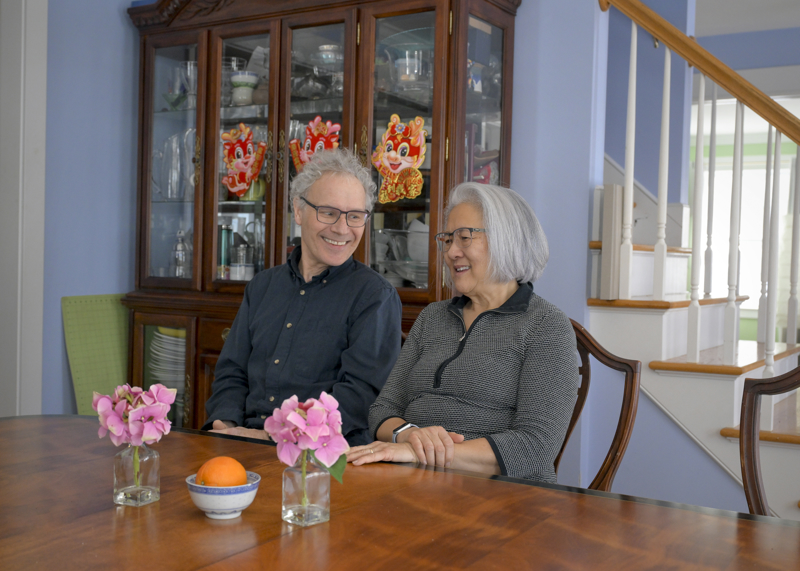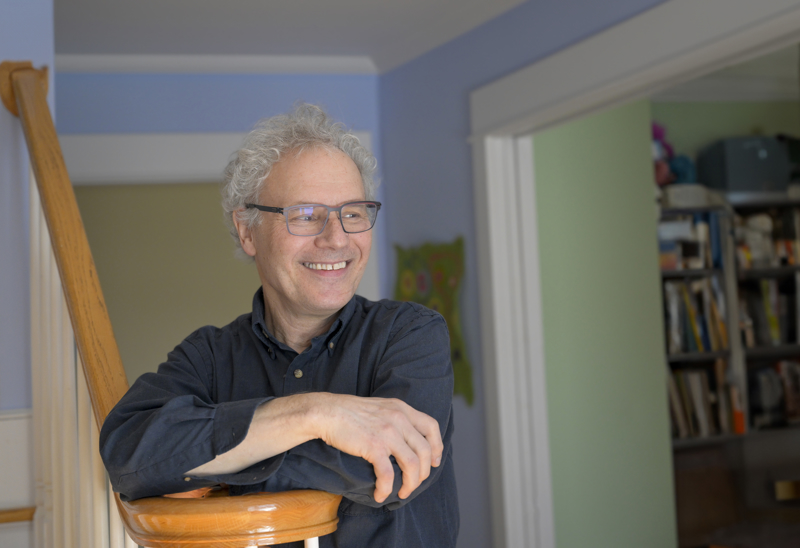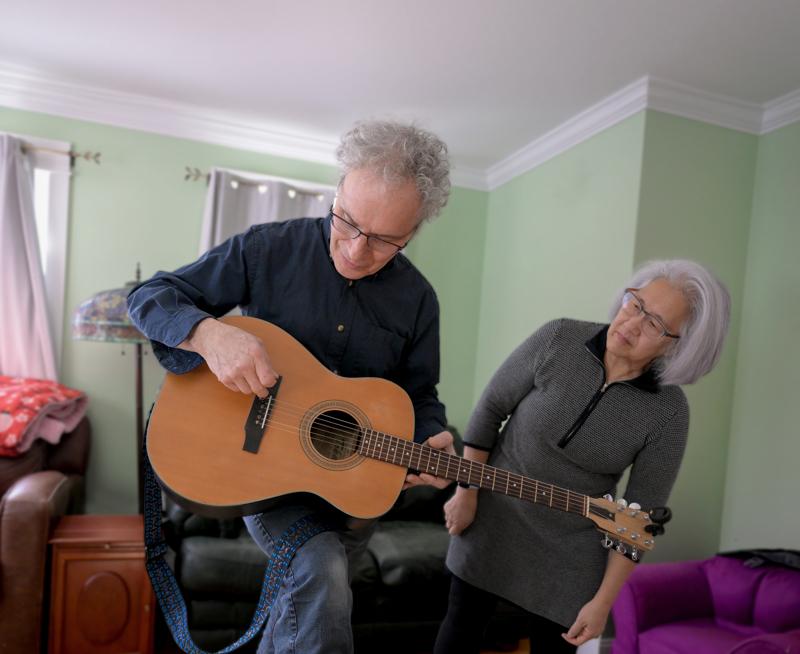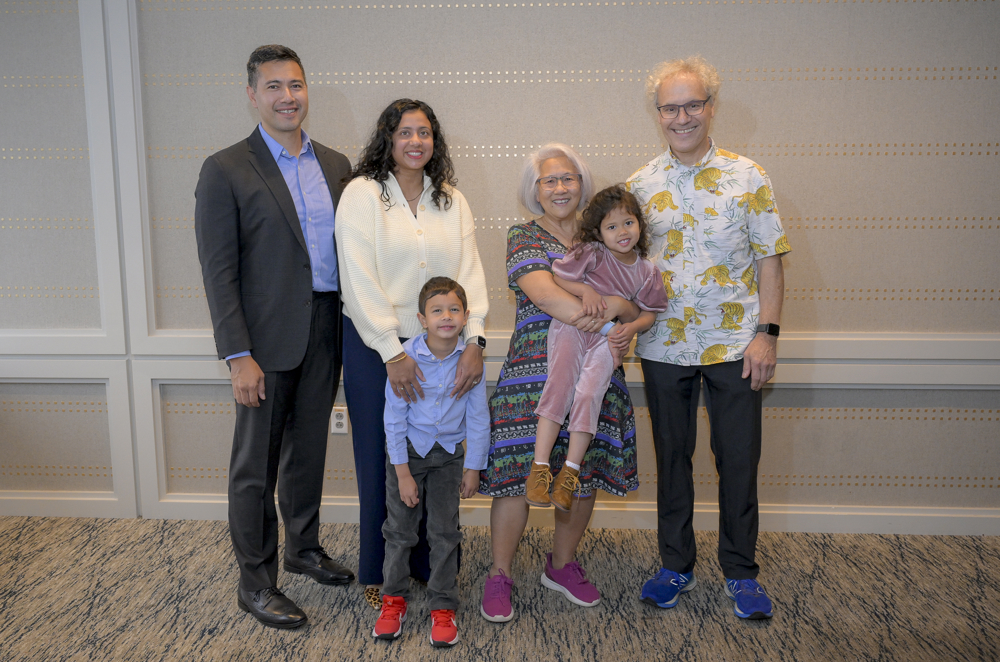Victor Ambros and Rosalind (Candy) Lee: A life in microRNA
By Jim Fessenden

Victor Ambros, PhD, and Rosalind “Candy” Lee at their home in Central Massachusetts.
(Photo: Faith Ninivaggi)
A few years ago, 2024 Nobel laureate Victor Ambros and his wife and scientific collaborator, Rosalind “Candy” Lee, purchased a washer and dryer set. Like many of the items around the Ambros-Lee household, the set had been given a new life by the couple, who bought it second-hand from a gentleman who had refurbished it. After installing the machines, putting one on top of the other and hooking up the plumbing, like good scientists, they tested their handiwork. “All we could hear was this loud bang, bang, bang,” said Dr. Ambros, the Silverman Chair in Natural Sciences and professor of molecular medicine at UMass Chan Medical School.
With an instinct to reuse and repurpose and curious about what was causing the noise, the pair, like many of us would, turned to YouTube for answers. They scrolled through and watched videos on how washers work and how to repair them. Having learned what they could, they unhooked the hoses and began meticulously taking the machine apart, removing the agitator and inspecting the motor, looking for the source of the noise.
“And so, here we are, two people in their 60s, taking the dryer off the washer and then taking the washer away,” said Ambros, glancing quickly at Lee to confirm he’s remembering correctly. “And then moving the washer out and taking it apart.”
It wasn’t a difficult job, but working in a confined space and dealing with water made the task challenging. Ambros and Lee eventually discovered an old screwdriver clanging around inside the barrel of the washer.
“Apparently it had fallen in while the repairman was working on it,” said Ambros.
Inside the lab, the husband-and-wife scientific team operate in a similar fashion—bouncing ideas off each other, diagnosing problems and plotting solutions.
“That’s how we were educated,” said Lee, who graduated from the Massachusetts Institute of Technology in 1976 with a degree in chemistry, the same year she and Ambros married. “The core of what we did at MIT, no matter what field you studied, was all about problem solving.”
Ambros, who earned his undergraduate and graduate degrees from MIT, added, “The idea is, you’re always the amateur. You don’t have to be an expert; you can go and find an expert and find out what they might suggest. You find the resources you need to solve the problem in front of you and develop the experience along the way. We have this style of approaching problems, where it’s an interesting puzzle, whether it’s a dishwasher, guitar or science.”
In the beginning
At home, Lee tends to be the idea person, developing projects, such as refurbishing a washing machine, and it’s Ambros who’s the craftsman and tactician. In the lab, however, Ambros takes on the role of strategist and Lee is the craftsperson, designing and executing bench experiments.
It was Lee, now a semi-retired senior scientist at UMass Chan, who was the first author, along with Ambros and Rhonda Feinbaum, PhD, then a postdoc in the Ambros lab, on the pivotal 1993 Cell study credited with identifying the first microRNA.
Now recognized as a groundbreaking discovery— revealing a new principle of gene regulation that turned out to be essential for multicellular organisms, including humans—the identification of the first microRNA almost didn’t happen. And likely wouldn’t have if not for Lee.
After working in various labs around Boston and Cambridge for several years, Lee joined the Ambros lab in 1987. She began working on the lin-4 project in 1989 only after the postdoctoral student who was originally pursuing the project left after three months because it was moving so slowly.
“There are not many who could have taken on this project . . . it’s rare to have a technician who’s as talented and accomplished, with 10 years of experience, as Candy is in the lab.”
At a time when simply cloning a gene could take several years, even with the most advanced technology available, not many graduate or postdoctoral students wanted to spend a large chunk of their early careers pursuing a project that might not culminate in a publication, said Ambros, which can be key to moving their careers forward.
“The fear was that after cloning lin-4, it might turn out tobe just a curiosity of C. elegans, and not terribly instructive about development, let alone biology,” Ambros said.
As a result, it was Lee and Dr. Feinbaum who designed the experiments and performed the painstaking work of cloning the lin-4 gene to identify its sequence.

(Photo: Faith Ninivaggi)
“There are not many who could have taken on this project,” said Ambros. “It’s rare to have a technician who’s as talented and accomplished, with 10 years of experience, as Candy is in the lab. It really was the perfect storm.”
It took several years, but with each successive experiment, they found the sequence for lin-4 becoming unexpectedly smaller and smaller.
“Even as a protein gene, we knew this was going to be a small protein,” said Ambros. “So, we felt we were on to something really interesting.”
Following their curiosity
The story of microRNA’s discovery begins in the lab of Ambros’ postdoctoral adviser and 2002 Nobel laurette H. Robert Horvitz, PhD, who, along with his collaborator and co Nobelist John Sulston, PhD, had worked out and annotated the cell-by-cell development of C. elegans in real time. It turns out that every worm goes through the same cellular development at precisely the same time without fail. Given the predictability of this process, Ambros began studying abnormal worms that showed a disrupted developmental cycle with the goal of teasing out the mutant gene, its product and biochemical activity, with the goal of relating these back to the abnormal behavior.
“It is an unbiased approach to science,” said Ambros. “You find a mutant and you follow that mutant and find out what it can teach you about that system.”
It was while investigating one of these developmentally abnormal C. elegans that microRNA was discovered. Looking to explain how a mutation to the lin-4 gene caused C. elegans to remain stuck in a juvenile state, Ambros knew from previous work that this gene somehow controlled the output of the lin-14 protein. Worms with mutant lin-4 had persistently high levels of lin-14, which caused them to repeat the first larval stage of development without ever progressing to the next stage.
Expecting to find that the lin-4 gene coded for a very small regulatory protein that would stop production of the lin-14 protein, which in turn would allow the worm to progress to the second larval stage of development, Ambros and colleagues found something much different. It wasn’t until a colleague at a floor meeting presentation, seeing the “schmutz” at the bottom of one of Ambros’s gels, suggested looking at even smaller molecules that the lin-4 mutation was narrowed down to 22 nucleotides.
Because of the size, Ambros and colleagues knew this wasn’t a protein. Instead, lin-4 encoded for a very short, single-stranded RNA molecule that scientists now know as microRNA. This microRNA was responsible for putting the brakes on the machinery necessary for creating the lin-14 protein. As a result, worms with a mutated lin-4 gene were unable to produce the microRNA necessary for shutting off the lin-14 gene that would allow the worm to mature normally.
However, it seemed that the initial fears that lin-4 was only an oddity of C. elegans might prove to be true. Then, six years later, Gary Ruvkun, PhD, professor of genetics at Harvard Medical School and Massachusetts General Hospital and co-recipient of the 2024 Nobel Prize in Physiology or Medicine, identified let-7, a second microRNA in C. elegans. By 2001, Ambros and other scientists had identified multiple microRNAs in worms, flies and humans.
Today, we know that microRNAs are evolutionarily ancient and regulate gene activity in all cells as part of the RNA interference pathway (for which UMass Chan Distinguished Professor Craig C. Mello was awarded the 2006 Nobel Prize in Physiology or Medicine). Researchers have now identified more than 1,000 unique human microRNAs that are responsible for regulating more than half of all human genes.
Introducing Ambros to the Swedish audience prior to his Nobel lecture on Dec. 7, president of the Karolinska Institute Annika Östman Wernerson, MD, noted how the discovery of microRNA highlights the importance of curiosity-driven research.
“This discovery of fundamental new mechanisms of gene regulation would probably not have been if goals for the research were predetermined,” said Dr. Östman Wernerson.
It was curiosity, and not a predefined outcome, that led Ambros and Lee to the discovery of microRNA.
That’s one of the problems with sciences today, said Lee. “Nobody wants to fund curiosity-based ideas anymore. They want to fund a goal. And when you put the constraint of producing a product on science, then you’re going to be biased to that outcome. You might try to force something that isn’t there or miss something you hadn’t considered.”
At home
Over more than three decades as investigators at Harvard University, Dartmouth College and UMass Chan, Ambros and Lee somehow found time to raise three sons. Today, their children are grown and have kids of their own. The four grandkids, all under 10 years of age, are frequent visitors to Ambros and Lee’s homes in Central Massachusetts and New Hampshire. The families often spend time together in New Hampshire where Ambros still spends time pursuing the astronomy that first got him interested in science as a teen.
For Lee, who has a large extended family, having children was always something that she felt strongly about.
“Family, and being Chinese, is really important for my identity,” explained Lee. “That’s something that I’ve tried to impart to my kids and now my grandkids. I’d like them to know they’re Chinese and we celebrate Chinese New Year and other events.”
Recently, Lee found a Chinese dragon dance head at the Wachusett Recycling Center where she volunteers most weeks. “When that came in, I was like, when you put a price on that, I’m buying it. And they did, they saved it for me.”
Once again, Ambros and Lee went to work making something new out of something otherwise intended for a landfill.
“Victor and I got together, we made a back and hot glued some sequins on it,” said Lee, an avid quilter who has a workshop that Ambros built over their garage.
The salvaged dragon dance head was a hit with the grandchildren at Lee’s 70th birthday celebration.
“We wrangled all the grandkids under it, they were moving in all directions,” recalled Lee happily. “Then there was this one moment when they all got under there, with some help from the older kids, and they were all moving in the same direction, and then they all scattered again.
“It was a really nice moment,” said Lee in her understated style.
Likewise, Lee’s large extended family has become an important theme in Ambros’ life. “She had a very cohesive extended family,” he said. “People were always visiting each other, especially before we had children. A lot of them live around Boston and Waltham, but we’d go and visit Candy’s aunts and uncles and cousins in Washington, D.C., and Philadelphia. That’s really been a big blessing for me, right from the beginning.”
Growing up in a scientific household with parents doing Nobel caliber research, however, didn’t predispose their children to science.
“Before we even set foot on campus, the respect we received from people like the chancellor and Mike Czech was something we hadn’t experienced before from an administration.”
“In some ways, maybe, having two scientists working together might have been sort of unfortunate,” explains Lee. “It might have been a turn off.”
When home, the two would often talk about work, just off the top of their heads, as things came to them. For instance, if there was a problem in the lab, such as an experiment not working out as planned or a piece of equipment that’s broken, it comes up in conversation.
“We probably didn’t talk about the joy of doing science as much as we could have,” said Ambros. “There was always some problem that needed addressing and for a kid, that doesn’t sound like a lot of fun.”
The closest any of their children got to science was their oldest, who earned an undergraduate degree in genetics, went to law school and became a life sciences licensing attorney. The two others have careers as a computer programmer and public administrator, respectively.
Coming to UMass Chan
During their early years at Harvard and Dartmouth, it seemed there were hurdles constantly being placed in front of them that took them away from doing actual science. That changed substantially when the duo came to UMass Chan in 2008.
“Before we even set foot on campus, the respect we received from people like the chancellor and Mike Czech [founding chair of the Program in Molecular Medicine] was something we hadn’t experienced before from an administration,” said Lee. “There was just a sense of positivity, of ‘what can we do, how can we help you,’ that was different.”
It wasn’t just the support of the administration that impressed Ambros and Lee, however. The collaboration and collegiality of the faculty and the sense that everybody was pulling in the same direction throughout the institution was profoundly different than their previous experiences.
“It really is extraordinary, what the administration and UMass Chan have cultivated here,” said Ambros. “It’s a contrast in almost every dimension to what our experience had been.”
People were more than just willing to talk about science, share ideas and collaborate. At UMass Chan, equipment was routinely shared across labs and faculty would take the time to teach their colleagues how to use it. Everybody, right down to the building manager, Mike Gregory, was welcoming, responsive and excited to be a part of what was happening and the science that was being done, explained both Ambros and Lee.
“What came across loud and clear, is that UMass Chan is a place where people were having fun doing science and that wasn’t something we had experienced for a very long time, unfortunately,” said Ambros.
Part of the unique atmosphere at UMass Chan, according to both Ambros and Lee, is a result of its relative youth as an academic medical center. To compete with more established institutions, UMass Chan did things differently. It recruited and nurtured younger faculty more than its competitors. It also found ways to do more with less, be nimbler and more efficient.
“Younger faculty, like Craig Mello, were encouraged to pursue ideas like RNAi,” said Ambros. “The administration and senior faculty supported him when he wanted to follow this crazy new phenomenon without knowing where it might end up.”
Another institution might not have done that, according to Lee.
A new beginning
As might be expected, being awarded the Nobel Prize in Physiology or Medicine has been life-changing for Ambros and Lee, who described the event as having ushered them into a new phase of their scientific careers.
“It’s taken some getting used to,” said Lee, who said she’s more comfortable out of the public’s eye. “You start to think of yourself in a different way, and you have to step up as a different person, because suddenly people are just happy and excited when you show up and that’s a serious responsibility.
“In the past, the focus would be on Victor,” said Lee. “They’d gather around him and want to talk to him. Now, I have to be more willing to interact and engage. People want to hear from me as well. It’s made me much more extroverted than I normally am.”

(Photo: Faith Ninivaggi)
At 71 years old, and with Lee already semi-retired, Ambros is naturally wondering when he might take a step back from the lab and start thinking about retirement. But the advent of CRISPR and other gene editing systems has changed how laboratory science is done. In the last few years, Ambros has been spending more time in the lab, doing experiments he loves.
“It feels great because you do a little experiment and you get results so fast,” said Ambros, getting excited. “That’s been one of the biggest changes in the lab: the speed with which we can do things.
“It’s been great to get back into the lab and become competent at some of these techniques that I was really rusty at or had never tried because I’m from an older generation,” he said. “It’s good to have that feeling of competence and the confidence that come with doing something and seeing it to completion.”“It’s been great to get back into the lab and become competent at some of these techniques that I was really rusty at or had never tried because I’m from an older generation,” he said. “It’s good to have that feeling of competence and the confidence that come with doing something and seeing it to completion.”
Lee added, “I can see him getting sucked into that because it’s not a long-haul sort of thing like it was 20 or 30 years ago. He’s offering to do experiments for other people or make [C. elegans] crosses for people, making mutations, the things I used to do. He’s having so much fun doing them.”
The other contributing factor to Ambros’ newfound excitement is his recent involvement with the AGO Alliance, a foundation dedicated to curing a new class of neurodevelopmental disorders called Argonaute syndromes, which are caused by microRNA disruption.
In 2021, a team of researchers led by Amélie Piton, PhD, associate professor of genetics and pathophysiology in neurodevelopmental disorders at the Institute of Genetics, Molecular and Cellular Biology in Strasbourg, France, described the first Argonaute related syndrome in humans caused by a mutation in the AGO1 gene. Meanwhile, a team led by Davor Lessel, MD, PhD, head of the Institute of Human Genetics at University of Regensburg in Germany, and Hans-Jürgen Kreienkamp, PhD, professor of human genetics at University of Hamburg in Germany, discovered in 2020 an AGO2-related syndrome, now known Lessel-Kreienkamp or Leskres syndrome.

(Photo: Faith Ninivaggi)
This year, Ambros and colleagues reported in the Proceedings of the National Academy of Sciences that the gene-silencing work of the RNA interference process is disrupted by mutations associated with Argonaute syndromes. Specifically, Ambros and colleagues showed single amino acid changes found in mutations associated with the newly identified Argonaute syndromes globally disrupt the microRNAmediated silencing process.
These genetic mutations, studied by Ambros and colleagues in the C. elegans model, cause an organismwide disruption of microRNA levels and messenger RNA translation, impacting hundreds of different genes, some of which are associated with neurodevelopment. These findings promise to help inform clinical and translational researchers in their pursuit of a treatment for Argonaute syndromes.
“We’re at the end of careers,” said Ambros. “And we have this astonishing opportunity to have an impact on a human disease in a very direct way. We’re directly involved in studies and things are moving so fast. There are so many people who are committed to this, it’s profound, to have an opportunity to contribute something, in our own small way.”
“There are so many people who are committed to this, it’s profound, to have an opportunity to contribute something, in our own small way.”
Hanging on the wall of Ambros and Lee’s living room is a Tokai guitar. Among the many things Ambros learned from his father, Longin Ambros, who worked as a cabinet maker and carpenter on his dairy farm in Hartland, Vermont, was woodworking. Rescued from the trash, the 1970s-era guitar was refurbished by Ambros. Using a steam iron, he pried up the instrument’s wood veneer and rebuilt the front bracing of the guitar and re-anchored the strings.
Even though he refurbishes and makes acoustic guitars as a hobby, Ambros admits he doesn’t play much or very well. “I can strum a few chords, but I’m always amazed when my son picks up one of the guitars and plays. It sounds so much better than when I do it.”
Lee added, “I keep trying to get him to take lessons because he’s never had any formal training.”
“It’s almost therapeutic,” explained Ambros when asked why he builds guitars when he doesn’t play. “In the lab we’re always working with these tiny amounts of liquid and microscopic worms. Building a guitar is a much more macro endeavor.”
Like working at the bench, however, building a guitar involves stripping the instrument down to what really matters: the bracing, how the strings are anchored and the tension in the strings.
“You really have to envision in your head how these things come together and work,” said Ambros. Not unlike genetics.
And like lab work, “you have to try different things before you find something that might work,” said Ambros. “Ultimately, everybody who builds guitars thinks they’re going to invent something new or come up with some innovative bracing scheme that the folks at Martin [the well-known guitar-making company] never thought of and it’s going to be magically better than anything else. But that’s not likely to happen.”
Maybe not, but in the case of the discovery of microRNA, for Ambros and Lee, that’s exactly what happened. ■